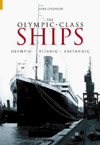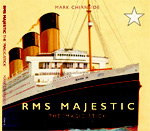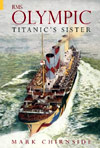|
| To Search This Site Enter Key Words Into Text Field On The Right and Hit The Search Button |
|
|
Mark Chirnside. For more information about the author visit his website Chirnside's Reception Room .
 |
Chirnside, Mark. The Olympic Class Ships: Olympic, Titanic, Britannic. 1st printing. Gloucestershire: Tempus Publishing. October, 2004. wraps. isbn: 0752428683. scarcity: hard to find.
Titanic is arguably the most famous ship in history, and her popularity has often come at the expense of her siblings. Yet she was but one of a trio of sister ships. The number of titles that have attempted to tell the story of all three liners in one volume is astonishingly short.
In this new book, Chirnside has done the triplets proud, with a thoroughly researched history of each of these vessels. Like many new authors, he is still finding his voice. Some of his language is a bit stilted at times, and there are some places where his precise meaning isn’t clear. But these glitches are minor, and shouldn’t distract you from enjoying this book. In particular, if you are into the technical aspects of these ships, you are in for a treat.
The book opens with several introductory chapters that set the stage for the construction of the Olympic class. Chapters one and two cover in brief detail the history of the Oceanic Steam Navigation Company (better known as the White Star Line), and the shipbuilding firm Harland and Wolff. Because they figure large as the competition, there is also a short chapter on Cunard’s speed demons Lusitania and Mauretania.
With the introductions taken care of, the text jumps right into “The Birth of the Olympics”, the story of the planning, building and launching of Olympic and Titanic. This chapter is almost a mini Shipbuilder, with a surplus of specifications about this class of ships. Coverage in this chapter turns technical, going into detailed explanations of the deck arrangements and structure, machinery and equipment, watertight subdivisions, pumping abilities, even a detailed analysis of passenger access to the boat deck for all three classes. If this sort of technicality leaves you cold, you can probably skim most of this section. But for the rivet counters amongst you (and you know who you are), this chapter makes for fascinating reading. Passenger and crew accommodations aren’t ignored either, information on these subjects are well represented.
From here the book turns to the story of each ship individually. Olympic is first, of course, and has the most coverage, as she had the longest career. There is always a tradeoff in a work like this. You can’t tell everything there is to tell if you are trying to cover the history of three ships in one book. But the major events of her service are represented. What we don’t get in quantity, is more than made up for in quality, as the depth of detail goes beyond most other titles. Every book about Olympic goes over the story of the Hawke collision, for example, but few cover the material as thoroughly as Chirnside does. Aside from the highlights of her years of service, there is extensive information about the vessel’s various upgrades, repairs and refits as she voyaged on over the years. Also covered in more detail than I have ever seen before, are many examples of the ship’s crossing times at different points in her career.
No ship is an island, if I may mangle an old adage, and the Olympic chapter also features a wealth of information about many other liners that were afloat during her time at sea. Details about some of White Star’s other ships, before and after Olympic are covered, most notably about her post World War siblings. There is a solid amount of material on many of the competing lines’ ships as well, all weaving a rich tapestry of maritime history in peace and in war spanning several decades.
The Titanic chapter is substantial in size, almost as long as Olympic’s. The author makes liberal use of survivor testimony throughout, giving the reader a real you-are-there sense to the story. There is not a lot of groundbreaking material in the Titanic chapter, but the details are covered with the same thoroughness as was found in the one on Olympic. It begins with the ship loading at Southampton in preparation for embarkation. The maiden voyage is covered including various information about passengers and crew. There are discussions of the ship’s speed and engine revolutions, as well as a good record of the ice warnings received.
The mechanics of what happened just prior to, during, and immediately after the collision are only lightly touched upon, but the drama of the sinking is covered very well, as is the launching of the lifeboats. One new theory that intrigued me was the author’s belief that it was not boiler room five’s bulkhead that collapsed, but rather merely the bunker door that gave way. Chirnside’s argument for his conclusion seems reasonable.
Carpathia’s part is covered with the usual commentary, and there are brief accounts of the aftermath, and the ships sent out to collect the bodies of the victims. Another nice touch is a three page documentation of all the wireless messages Phillips sent out during the sinking. There are also substantially detailed overviews of both the American and British inquiries, again packed with testimony. This is a highlight, and probably the best overview of the inquiries I have read to date.
The section on Britannic is the shortest of the three, but still manages to cover the high points of her career. Aside from the huge, new lifeboat davits, many readers probably don’t know that this ship differed from her siblings in many appreciable ways. The author corrects this popular misunderstanding by going into extensive detail about just how different she really was, taking up almost the entire first third of the chapter. He explains the many ways she was structurally altered after the Titanic disaster to make her a safer vessel. All the updates, additions and alterations to her equipment and accommodations are also explained in thorough detail.
There follows a brief, but concise section on Britannic’s launch and her first five voyages as a hospital ship during the First World War. The final third of this chapter covers her disastrous sixth voyage, when the ship was sunk after striking a mine in the Aegean sea. As with the Titanic chapter, Chirnside turns to the survivor’s own words to tell the story of the sinking and the rescue.
There are no less than eleven appendices exploring a wide range of related topics including the fictional story Wreck of the Titan, a comparison of Britannic and Aquitania, Olympic’s new sisters after the First World War, the Californian, Titanic’s legacy and more. Of these, by far the most interesting is Chirnside’s research into the amount of coal Titanic had on her maiden voyage. He presents a strong case that, rather than short on coal, as has been the accepted belief, Titanic actually had more coal aboard for her maiden voyage than Olympic had on her’s.
There are eleven pages of footnotes, and a two page bibliography. My only real gripe is the embarrassingly short, one page index. Completely insufficient for the volume of information to be found in this book.
If you are primarily interested in a social history of these vessels, this book may not be your cup of tea. Not that such material is lacking, there is plenty of history packed into these pages, the actual amount varying for each vessel. There is quite a lot of technical information about Olympic and Britannic; not as much in the Titanic chapter, which focuses more on the drama of the tragedy. Overall, the author manages to balance the two types of material effectively. But it is definitely in the technical side of the story that the author has uncovered the most original research. The volume of technical data he has collected on the Olympic class has rarely, if ever, been equaled.
You might also be disappointed if you prefer your books packed with imagery. This book is nicely illustrated, and even includes some very rare photographs, published here for the first time. But this is not an extensively illustrated book, the highlight here is definitely the words, not the pictures.
Has the ultimate history of the Olympic class trio been achieved in this book? Maybe. Maybe not. But Chirnside has come closer to hitting the bulls eye than any writer before him.
|
 |
Chirnside, Mark. RMS Majestic: The Magic Stick. 1st printing. Gloucestershire: Tempus Publishing. 2006. wraps. isbn: 0752438778. scarcity: fairly common.
From the publisher’s press release:
Laid down and constructed for the German Hamburg-Amerika Line, Majestic was later ceded to Britain’s White Star Line to replace the Britannic, a sister ship of Titanic sunk during the First World War. At 56,000 tons, she enjoyed a long reign as the world’s largest ship. She spent most of her life on the Southampton–New York run but cruised to Canada as well as offering short cruises from Southampton. With sumptuous interiors as well as luxurious restaurants and public rooms, she plied her trade until 1936. Saved from the scrapyard, she was instead converted into a training ship for naval cadets, and sailed for Rosyth as HMS Caledonia, surviving until 1940, when she was burnt out.
With an extensive collection of archive pictures of the Majestic and other ships, including photographs of the White Star vessel’s stately rooms, and striking paintings of the ship in vibrant colour, as well as a fascinating and comprehensive narrative chronicling the life of the vessel, RMS Majestic: The ‘Magic-Stick’ provides a complete history of a ship that was once the pride of the White Star Line.
For further details, see the publisher's website.
|
 |
Chirnside, Mark. RMS Olympic, Titanic’s Sister. 1st printing. Gloucestershire: Tempus Publishing. November, 2004. wraps. isbn: 075243148X. scarcity: hard to find.
|
|
|
|
|